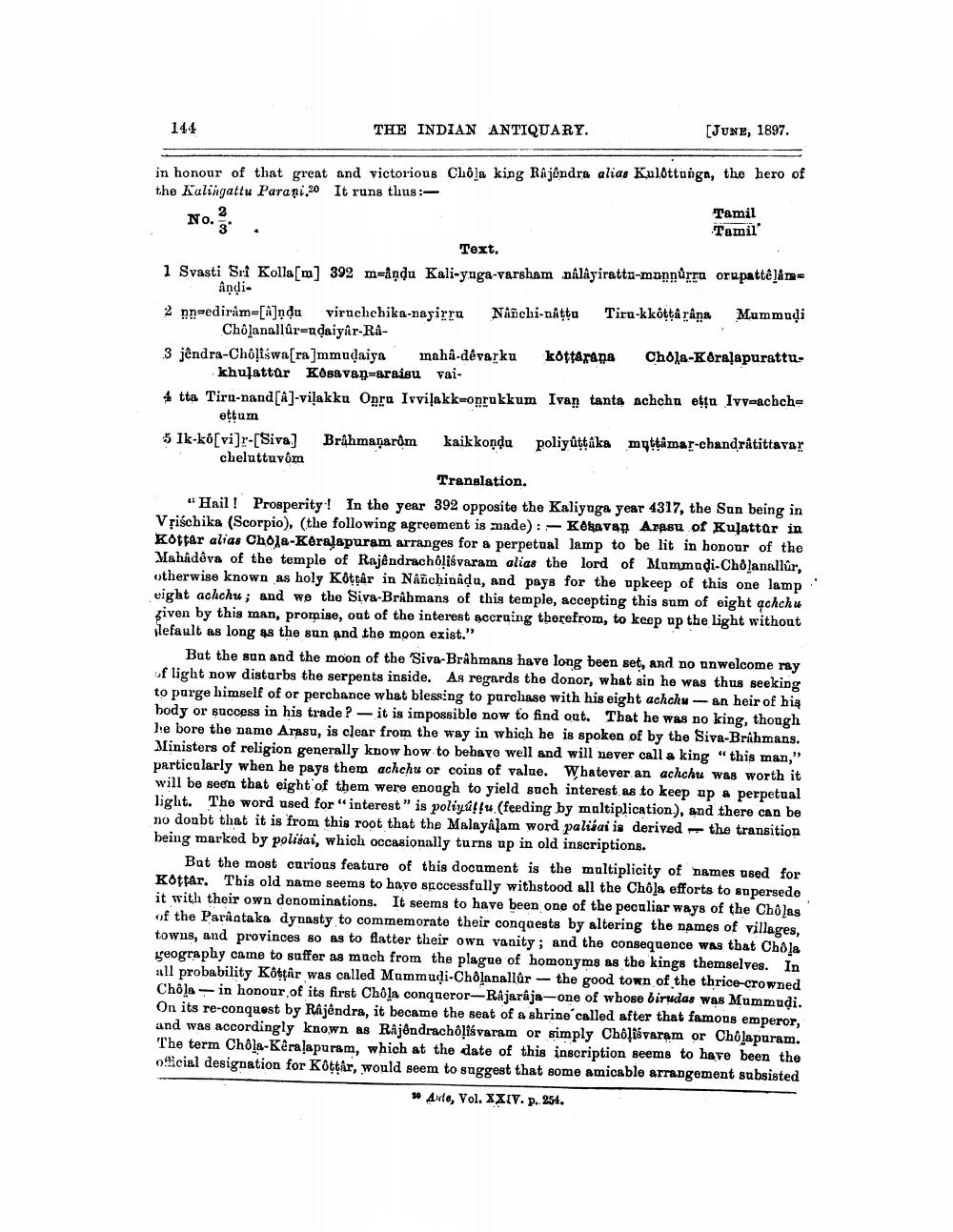________________
144
THE INDIAN ANTIQUARY.
(June, 1897.
in honour of that great and victorious Chola king Rajendra alias Kulottangn, the hero of the Kalingattu Parani 20 It runs tlus:
Tamil No.
Tamil
Text. 1 Svasti Sri Kolla[m] 392 m=aņdu Kali-yaga-varsham nalayirattu-monnurra orupattelare
andi2 n-ediram-[A]ndu viruchchika-nagirru Naichi-nattu Tiru-kkötta râna Mummuļi
Cholanallur=udaiyar-Ra3 jêndra-Choļiśwa[ra]mmudaiya maha-dêvarku kottarapa Chola-Kéraļapurattu
khulattar Kosavan-araisu vai4 tta Tiru-nand[A]-vilakku Opra Ivviļakkoonrukkum Ivan tanta achcha eta Ivv-achch
ettum 5 Ik-k6[vi]r-[Siva] Brahmanarôm kaikkonda poliyattaka myttamar.chandråtittavar cheluttuvôm
Translation. Hail! Prosperity! In the year 392 opposite the Kaliyuga year 4317, the Sun being in Vțiśchika (Scorpio), (the following agreement is made): -Kekavan Arasu of Kulattor in Kottar alias Chola-Keralapuram arranges for a perpetual lamp to be lit in honour of the Mahadeva of the temple of Rajendrachliśvaram alias the lord of Mummudi-Chồlanallür, otherwise known as holy Kottar in Naiichinada, and pays for the upkeep of this one lamp eight achchu; and we the Siva-Brahmans of this temple, accepting this sum of eight achchu given by this man, promise, out of the interest accruing therefrom, to keep up the light without ilefault as long as the sun and the moon exist."
But the sun and the moon of the Siva-Brahmans have long been set, and no unwelcome ray of light now disturbs the serpents inside. As regards the donor, what sin he was thus seeking to purge himself of or perchance what blessing to purchase with his eight achchu - an heir of his body or success in his trade? - it is impossible now to find out. That he was no king, though le bore the namo Arasu, is clear from the way in which he is spoken of by the Siva-Brahmans. Ministers of religion generally know how to bebayo well and will never call a king "this man," particularly when he pays them achchu or coins of value. Whatever an achchu was worth it will be seen that eight of them were enough to yield such interest as to keep up a perpetual light. The word used for "interest" is poliya!! (feeding by multiplication.), and there can be no doubt that it is from this root that the Malayalam word palikai is derived the transition being marked by polisai, which occasionally turns up in old inscriptions.
But the most curioas feature of this document is the multiplicity of names used for Kottar. This old name seems to have successfully withstood all the Chôļa efforts to supersedo it with their own denominations. It seems to have been one of the peculiar ways of the Cholas of the Parântaka dynasty to commemorate their conquests by altering the names of villages, towns, and provinces so as to flatter their own vanity; and the consequence was that Chồla geography came to suffer as much from the plague of homonyms as the kings themselves. In all probability Kottar was called Mummudi-Chôlanallûr - the good town of the thrice-crowned Chôla - in honour of its first Chola conqueror-Rajaraja-one of whose birudas was Mummudi. On its re-conquest by Rajendra, it became the seat of a shrine called after that famous emperor, and was accordingly known as Rajendrachôļiśvaram or simply Chôļiśvaram or Cholapuram.
The term Chola-Keralapuram, which at the date of this inscription seems to have been the oficial designation for Kottar, would seem to suggest that some amicable arrangement subsisted
* Arte, Vol. XXIV. p. 254.




